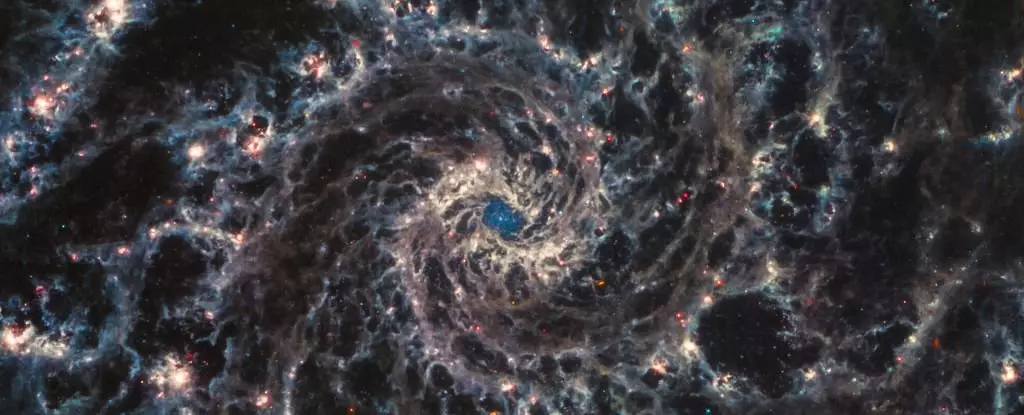The James Webb Space Telescope (JWST) has transformed our understanding of the universe since its much-anticipated launch three years ago. Marked by remarkable engineering and innovative design, this telescope represents a monumental leap forward in our ability to observe celestial phenomena with unprecedented clarity. Not merely a technological triumph, JWST has radically altered our cosmic narrative, shedding light on the early universe and presenting new enigmas that promise to reshape our scientific paradigms.
Unveiling the Early Universe
Before JWST, our exploration into the cosmos was primarily constrained by Earth’s atmosphere and previous telescopic technology. By positioning itself in the far reaches of space, JWST takes advantage of an unobstructed view of the universe, particularly using infrared light to penetrate cosmic dust and gas. This remarkable capability has facilitated the identification of galaxies dating back to just 300 million years after the Big Bang. Scientists have been astonished to discover that some of these ancient galaxies are exceedingly massive, containing up to 400 million solar masses—a clear indicator that star formation during the universe’s infancy was strikingly efficient.
One of the most puzzling revelations is the unexpected luminescence and color of these early galaxies, which are found to be bright and predominantly blue—contradicting previous hypotheses suggesting that they should be typically reddish due to the presence of cosmic dust. Such outcomes lead to various questions: It could suggest these galaxies housed massive stars that collapsed before exploding in supernova events, or perhaps the radiation from young, vibrant stars obliterated any dust present. The paradigm surrounding early galactic formation is shifting, demonstrating that our comprehension remains, at best, incomplete.
A deeper insight into the early cosmos reveals complexities that defy existing scientific models. Early galaxies, as discovered by JWST, exhibit chemical properties that diverge significantly from those of contemporary stars. In particular, they contain abnormally high levels of nitrogen while showing lower concentrations of other heavier metals. This peculiar mix sparks further inquiry into the processes that governed the universe’s elemental composition soon after the Big Bang. The revelations suggest not only that our models of galactic formation are lacking, but also that the chemical evolution of the universe comprises various mechanisms that remain poorly understood.
The accurate mapping of these chemical features is imperative for astrophysicists, as they act as a historical record of the universe’s evolution. Additionally, understanding how elements such as oxygen and iron emerged from these early stars is crucial to grasping the very foundations of life as we know it.
The Dance of Light and Dark
Utilizing massive clusters of galaxies to amplify its view, JWST has demonstrated its ability to detect faint cosmic objects previously obscured from view. As it searches for boundaries above which galaxies cease to form stars, researchers are discovering enigmatic galaxies that emit a staggering amount of energetic photons—four times what was initially anticipated. This suggests that these smaller, less-characterized galaxies played an instrumental role in the universe’s early evolutionary phases, possibly ending the so-called “cosmic dark ages.”
Moreover, JWST’s first images unveiled an array of mysterious “little red dots.” At first considered ultra-compacted galaxies, these objects defy conventional classification due to their contradictory characteristics. The light emitted from them exhibits patterns typically indicative of supermassive black holes in the act of devouring surrounding gas. However, their lack of detectable high-energy emissions suggests a dissonance in our existing understanding of galactic nuclei. Could these peculiar entities represent a unique evolutionary stage of celestial formation? The inquiry inspires deeper analysis and highlights the potential for complex interactions between stars and black holes during the universe’s infancy.
Galactic Corpses and New Paradigms
While JWST has identified vibrant young galaxies, it has also uncovered the remnants of once-thriving celestial bodies—galaxies that accumulated mass and formed stars intensely, only to reach a premature death. Prior observations by telescopes like Hubble identified these remnants, but it was JWST that enabled astronomers to dissect their light more effectively, revealing their early formation periods within the universe.
The mass and formation timelines of some of these galaxies—akin to or even exceeding that of our Milky Way—pose challenging questions for contemporary galaxy formation models. The extensive mass and rapid onset of formation underscore an enduring debate: Are we looking at a surprisingly efficient early star formation? Or has our understanding of dark matter and its role in early cosmic history drastically misled us?
In just three years of telescope operations, JWST has illuminated multiple facets of our cosmic history while simultaneously underscoring the limits of our current models. Numerous mysteries, such as the nature of the “little red dots” and the early galaxies, beckon further inquiry. As astronomers process this vast new dataset, they will refine theories, delve into unknown territories, and perhaps even redefine our conceptual understandings of the universe.
NASA and the global scientific community eagerly anticipate future finds as JWST continues its mission. Each discovery propels us closer to comprehending our cosmic origins while inspiring an enduring curiosity about what lies beyond our field of view. Armed with monumental insights and newly emerged enigma, JWST stands on the precipice of astrophysical transformation, ready to propel our understanding of the universe into uncharted realms.


Leave a Reply